airbag off Seat Alhambra 2008 Owner's Manual
[x] Cancel search | Manufacturer: SEAT, Model Year: 2008, Model line: Alhambra, Model: Seat Alhambra 2008Pages: 295, PDF Size: 7.83 MB
Page 23 of 295
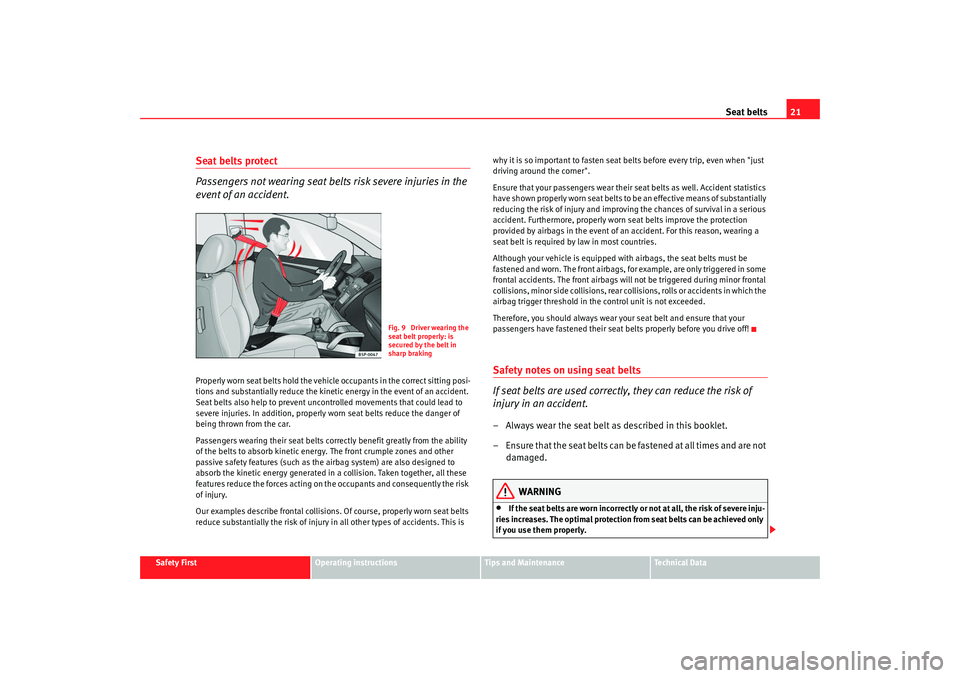
Seat belts21
Safety First
Operating instructions
Tips and Maintenance
Te c h n i c a l D a t a
Seat belts protect
Passengers not wearing seat belts risk severe injuries in the
event of an accident.Properly worn seat belts hold the vehicle occupants in the correct sitting posi-
tions and substantially reduce the kinetic energy in the event of an accident.
Seat belts also help to prevent uncontrolled movements that could lead to
severe injuries. In addition, properly worn seat belts reduce the danger of
being thrown from the car.
Passengers wearing their seat belts correctly benefit greatly from the ability
of the belts to absorb kinetic energy. The front crumple zones and other
passive safety features (such as the airbag system) are also designed to
absorb the kinetic energy generated in a collision. Taken together, all these
features reduce the forces acting on the occupants and consequently the risk
of injury.
Our examples describe frontal collisions. Of course, properly worn seat belts
reduce substantially the risk of injury in all other types of accidents. This is why it is so important to fasten seat belts before every trip, even when "just
driving around the corner".
Ensure that your passengers wear their seat belts as well. Accident statistics
have shown properly worn seat belts to be an effective means of substantially
reducing the risk of injury and improving the chances of survival in a serious
accident. Furthermore, properly worn seat belts improve the protection
provided by airbags in the event of an accident. For this reason, wearing a
seat belt is required by law in most countries.
Although your vehicle is equipped with airbags, the seat belts must be
fastened and worn. The front airbags, for example, are only triggered in some
frontal accidents. The front airbags will not be triggered during minor frontal
collisions, minor side collisions, rear collisions, rolls or accidents in which the
airbag trigger threshold in the control unit is not exceeded.
Therefore, you should always wear your seat belt and ensure that your
passengers have fastened their seat belts properly before you drive off!
Safety notes on using seat belts
If seat belts are used correctly, they can reduce the risk of
injury in an accident.– Always wear the seat belt as described in this booklet.
– Ensure that the seat belts can be fastened at all times and are not
damaged.
WARNING
•
If the seat belts are worn incorrectly or not at all, the risk of severe inju-
ries increases. The optimal protection from seat belts can be achieved only
if you use them properly.
Fig. 9 Driver wearing the
seat belt properly: is
secured by the belt in
sharp braking
alhambra_ingles_0708 Seite 21 Mittwoch, 10. September 2008 10:55 10
Page 32 of 295
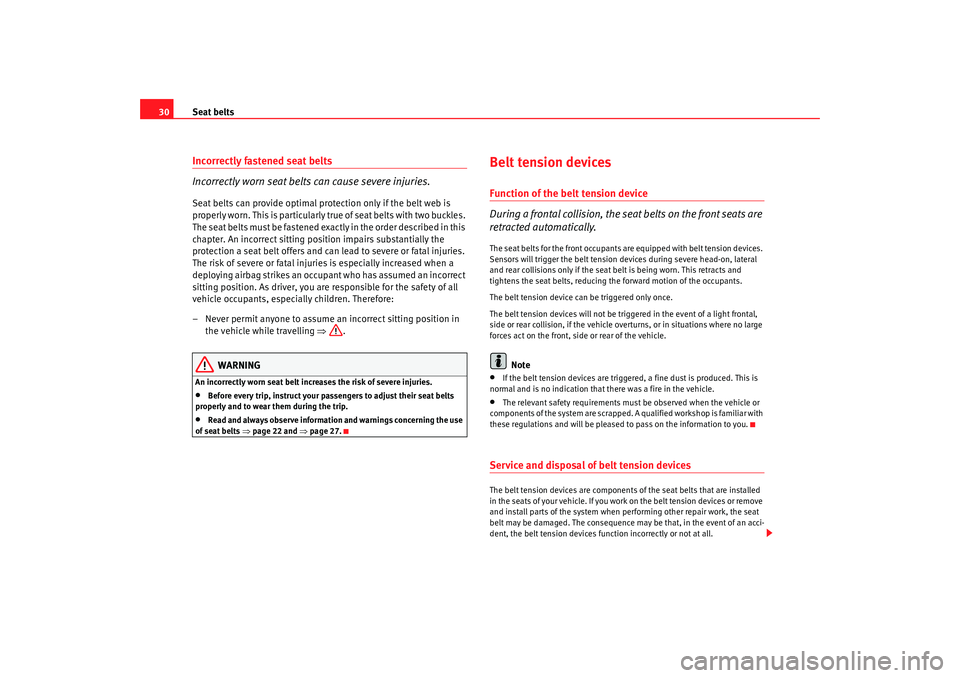
Seat belts
30Incorrectly fastened seat belts
Incorrectly worn seat belts can cause severe injuries.Seat belts can provide optimal protection only if the belt web is
properly worn. This is particularly true of seat belts with two buckles.
The seat belts must be fastened exactly in the order described in this
chapter. An incorrect sitting position impairs substantially the
protection a seat belt offers and can lead to severe or fatal injuries.
The risk of severe or fatal injuries is especially increased when a
deploying airbag strikes an occupant who has assumed an incorrect
sitting position. As driver, you are responsible for the safety of all
vehicle occupants, especially children. Therefore:
– Never permit anyone to assume an incorrect sitting position in
the vehicle while travelling ⇒.
WARNING
An incorrectly worn seat belt increases the risk of severe injuries.•
Before every trip, instruct your passengers to adjust their seat belts
properly and to wear them during the trip.
•
Read and always observe information and warnings concerning the use
of seat belts ⇒page 22 and ⇒page 27.
Belt tension devicesFunction of the belt tension device
During a frontal collision, the seat belts on the front seats are
retracted automatically.The seat belts for the front occupants are equipped with belt tension devices.
Sensors will trigger the belt tension devices during severe head-on, lateral
and rear collisions only if the seat belt is being worn. This retracts and
tightens the seat belts, reducing the forward motion of the occupants.
The belt tension device can be triggered only once.
The belt tension devices will not be triggered in the event of a light frontal,
side or rear collision, if the vehicle overturns, or in situations where no large
forces act on the front, side or rear of the vehicle.
Note
•
If the belt tension devices are triggered, a fine dust is produced. This is
normal and is no indication that there was a fire in the vehicle.
•
The relevant safety requirements must be observed when the vehicle or
components of the system are scrapped. A qualified workshop is familiar with
these regulations and will be pleased to pass on the information to you.
Service and disposal of belt tension devicesThe belt tension devices are components of the seat belts that are installed
in the seats of your vehicle. If you work on the belt tension devices or remove
and install parts of the system when performing other repair work, the seat
belt may be damaged. The consequence may be that, in the event of an acci-
dent, the belt tension devices function incorrectly or not at all.
alhambra_ingles_0708 Seite 30 Mittwoch, 10. September 2008 10:55 10
Page 36 of 295
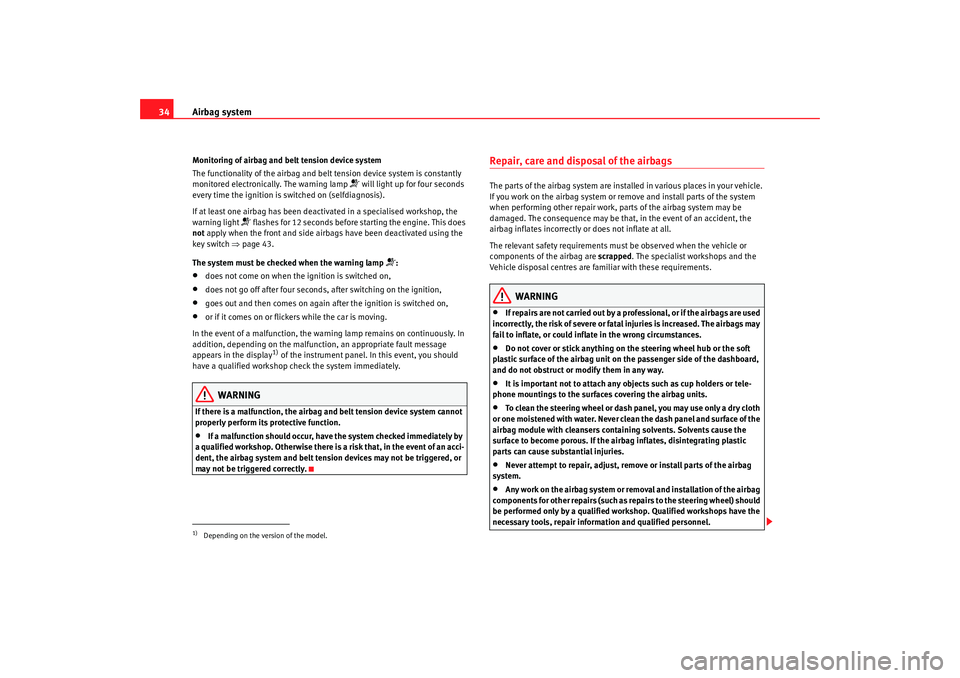
Airbag system
34Monitoring of airbag and belt tension device system
The functionality of the airbag and belt tension device system is constantly
monitored electronically. The warning lamp
will light up for four seconds
every time the ignition is switched on (selfdiagnosis).
If at least one airbag has been deactivated in a specialised workshop, the
warning light
flashes for 12 seconds before starting the engine. This does
not apply when the front and side airbags have been deactivated using the
key switch ⇒ page 43.
The system must be checked when the warning lamp
:
•
does not come on when the ignition is switched on,
•
does not go off after four seconds, after switching on the ignition,
•
goes out and then comes on again after the ignition is switched on,
•
or if it comes on or flickers while the car is moving.
In the event of a malfunction, the warning lamp remains on continuously. In
addition, depending on the malfunction, an appropriate fault message
appears in the display
1) of the instrument panel. In this event, you should
have a qualified workshop check the system immediately.
WARNING
If there is a malfunction, the airbag and belt tension device system cannot
properly perform its protective function.•
If a malfunction should occur, have the system checked immediately by
a qualified workshop. Otherwise there is a risk that, in the event of an acci-
dent, the airbag system and belt tension devices may not be triggered, or
may not be triggered correctly.
Repair, care and disposal of the airbagsThe parts of the airbag system are installed in various places in your vehicle.
If you work on the airbag system or remove and install parts of the system
when performing other repair work, parts of the airbag system may be
damaged. The consequence may be that, in the event of an accident, the
airbag inflates incorrectly or does not inflate at all.
The relevant safety requirements must be observed when the vehicle or
components of the airbag are scrapped. The specialist workshops and the
Vehicle disposal centres are familiar with these requirements.
WARNING
•
If repairs are not carried out by a professional, or if the airbags are used
incorrectly, the risk of severe or fatal injuries is increased. The airbags may
fail to inflate, or could inflate in the wrong circumstances.
•
Do not cover or stick anything on the steering wheel hub or the soft
plastic surface of the airbag unit on the passenger side of the dashboard,
and do not obstruct or modify them in any way.
•
It is important not to attach any objects such as cup holders or tele-
phone mountings to the surfaces covering the airbag units.
•
To clean the steering wheel or dash panel, you may use only a dry cloth
or one moistened with water. Never clean the dash panel and surface of the
airbag module with cleansers containing solvents. Solvents cause the
surface to become porous. If the airbag inflates, disintegrating plastic
parts can cause substantial injuries.
•
Never attempt to repair, adjust, remove or install parts of the airbag
system.
•
Any work on the airbag system or removal and installation of the airbag
components for other repairs (such as repairs to the steering wheel) should
be performed only by a qualified workshop. Qualified workshops have the
necessary tools, repair information and qualified personnel.
1)Depending on the version of the model.
alhambra_ingles_0708 Seite 34 Mittwoch, 10. September 2008 10:55 10
Page 38 of 295
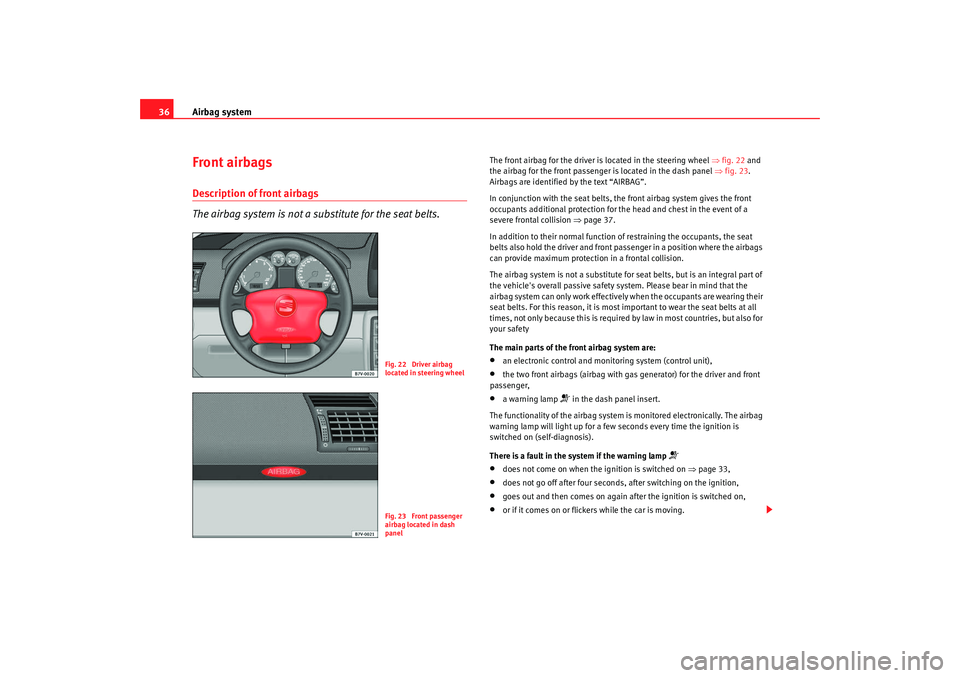
Airbag system
36Front airbagsDescription of front airbags
The airbag system is not a substitute for the seat belts.
The front airbag for the driver is located in the steering wheel ⇒fig. 22 and
the airbag for the front passenger is located in the dash panel ⇒fig. 23 .
Airbags are identified by the text “AIRBAG”.
In conjunction with the seat belts, the front airbag system gives the front
occupants additional protection for the head and chest in the event of a
severe frontal collision ⇒page 37.
In addition to their normal function of restraining the occupants, the seat
belts also hold the driver and front passenger in a position where the airbags
can provide maximum protection in a frontal collision.
The airbag system is not a substitute for seat belts, but is an integral part of
the vehicle's overall passive safety system. Please bear in mind that the
airbag system can only work effectively when the occupants are wearing their
seat belts. For this reason, it is most important to wear the seat belts at all
times, not only because this is required by law in most countries, but also for
your safety
The main parts of the front airbag system are:•
an electronic control and monitoring system (control unit),
•
the two front airbags (airbag with gas generator) for the driver and front
passenger,
•
a warning lamp
in the dash panel insert.
The functionality of the airbag system is monitored electronically. The airbag
warning lamp will light up for a few seconds every time the ignition is
switched on (self-diagnosis).
There is a fault in the system if the warning lamp
•
does not come on when the ignition is switched on ⇒page 33,
•
does not go off after four seconds, after switching on the ignition,
•
goes out and then comes on again after the ignition is switched on,
•
or if it comes on or flickers while the car is moving.
Fig. 22 Driver airbag
located in steering wheelFig. 23 Front passenger
airbag located in dash
panel
alhambra_ingles_0708 Seite 36 Mittwoch, 10. September 2008 10:55 10
Page 39 of 295
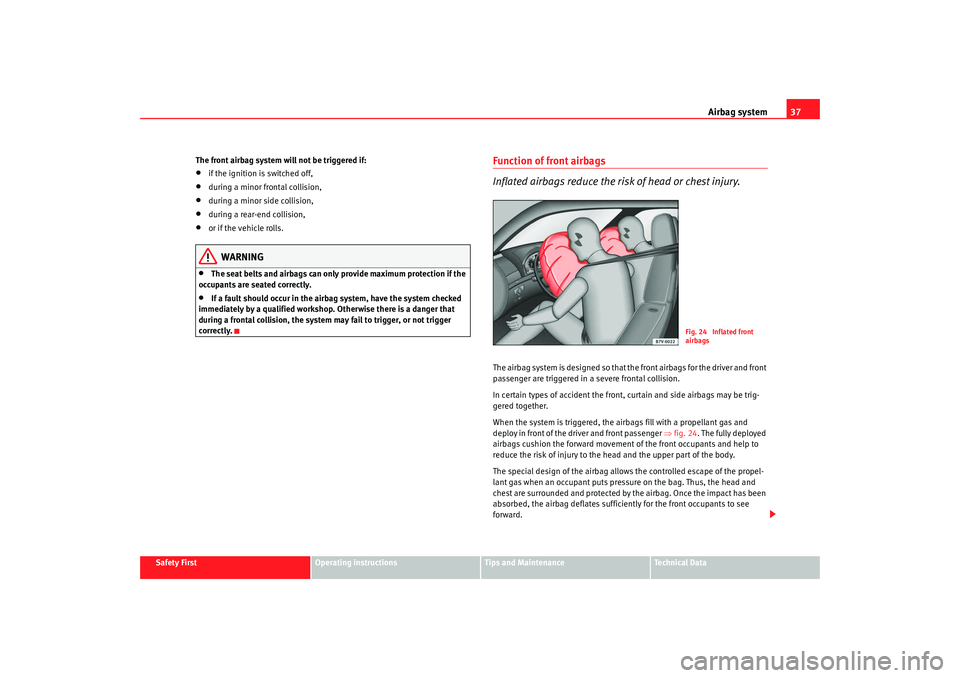
Airbag system37
Safety First
Operating instructions
Tips and Maintenance
Te c h n i c a l D a t a
The front airbag system will not be triggered if:
•
if the ignition is switched off,
•
during a minor frontal collision,
•
during a minor side collision,
•
during a rear-end collision,
•
or if the vehicle rolls.
WARNING
•
The seat belts and airbags can only provide maximum protection if the
occupants are seated correctly.
•
If a fault should occur in the airbag system, have the system checked
immediately by a qualified workshop. Otherwise there is a danger that
during a frontal collision, the system may fail to trigger, or not trigger
correctly.
Function of front airbags
Inflated airbags reduce the risk of head or chest injury.The airbag system is designed so that the front airbags for the driver and front
passenger are triggered in a severe frontal collision.
In certain types of accident the front, curtain and side airbags may be trig-
gered together.
When the system is triggered, the airbags fill with a propellant gas and
deploy in front of the driver and front passenger ⇒fig. 24 . The fully deployed
airbags cushion the forward movement of the front occupants and help to
reduce the risk of injury to the head and the upper part of the body.
The special design of the airbag allows the controlled escape of the propel-
lant gas when an occupant puts pressure on the bag. Thus, the head and
chest are surrounded and protected by the airbag. Once the impact has been
absorbed, the airbag deflates sufficiently for the front occupants to see
forward.
Fig. 24 Inflated front
airbags
alhambra_ingles_0708 Seite 37 Mittwoch, 10. September 2008 10:55 10
Page 41 of 295
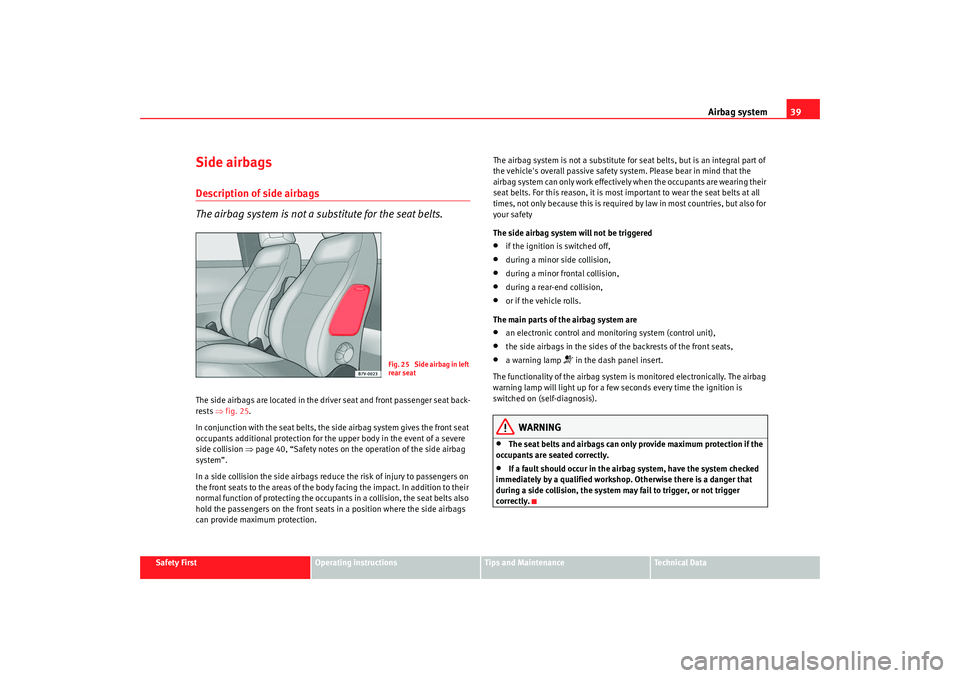
Airbag system39
Safety First
Operating instructions
Tips and Maintenance
Te c h n i c a l D a t a
Side airbagsDescription of side airbags
The airbag system is not a substitute for the seat belts.The side airbags are located in the driver seat and front passenger seat back-
rests ⇒fig. 25 .
In conjunction with the seat belts, the side airbag system gives the front seat
occupants additional protection for the upper body in the event of a severe
side collision ⇒page 40, “Safety notes on the operation of the side airbag
system”.
In a side collision the side airbags reduce the risk of injury to passengers on
the front seats to the areas of the body facing the impact. In addition to their
normal function of protecting the occupants in a collision, the seat belts also
hold the passengers on the front seats in a position where the side airbags
can provide maximum protection. The airbag system is not a substitute for seat belts, but is an integral part of
the vehicle's overall passive safety system. Please bear in mind that the
airbag system can only work effectively when the occupants are wearing their
seat belts. For this reason, it is most important to wear the seat belts at all
times, not only because this is required by law in most countries, but also for
your safety
The side airbag system will not be triggered
•
if the ignition is switched off,
•
during a minor side collision,
•
during a minor frontal collision,
•
during a rear-end collision,
•
or if the vehicle rolls.
The main parts of the airbag system are
•
an electronic control and monitoring system (control unit),
•
the side airbags in the sides of the backrests of the front seats,
•
a warning lamp
in the dash panel insert.
The functionality of the airbag system is monitored electronically. The airbag
warning lamp will light up for a few seconds every time the ignition is
switched on (self-diagnosis).
WARNING
•
The seat belts and airbags can only provide maximum protection if the
occupants are seated correctly.
•
If a fault should occur in the airbag system, have the system checked
immediately by a qualified workshop. Otherwise there is a danger that
during a side collision, the system may fail to trigger, or not trigger
correctly.
F ig . 2 5 S i de a ir b ag i n l e f t
rear seat
alhambra_ingles_0708 Seite 39 Mittwoch, 10. September 2008 10:55 10
Page 43 of 295
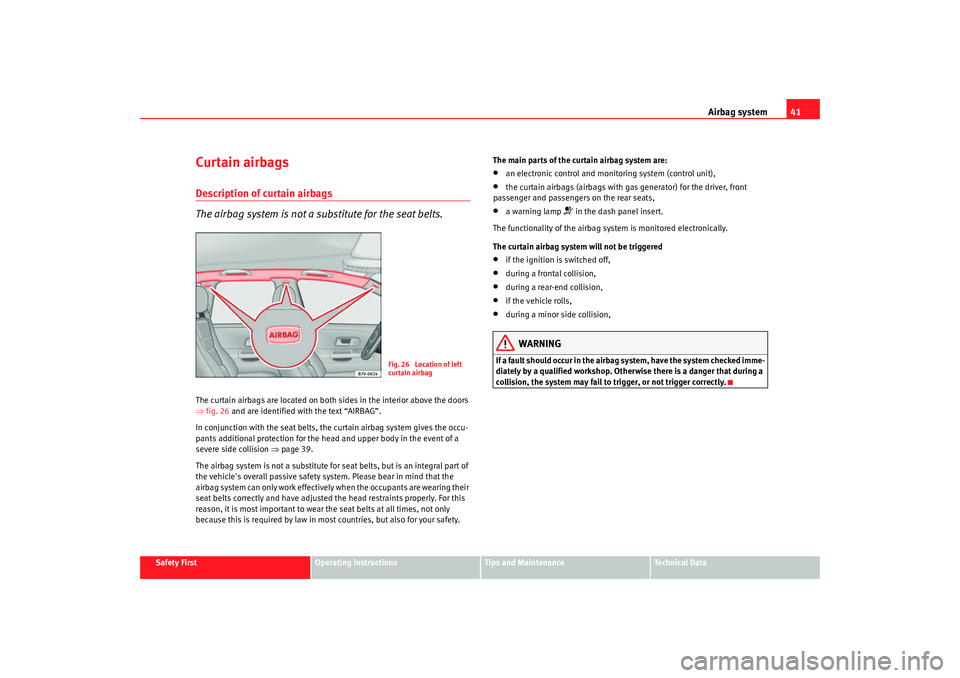
Airbag system41
Safety First
Operating instructions
Tips and Maintenance
Te c h n i c a l D a t a
Curtain airbagsDescription of curtain airbags
The airbag system is not a substitute for the seat belts.The curtain airbags are located on both sides in the interior above the doors
⇒fig. 26 and are identified with the text “AIRBAG”.
In conjunction with the seat belts, the curtain airbag system gives the occu-
pants additional protection for the head and upper body in the event of a
severe side collision ⇒page 39.
The airbag system is not a substitute for seat belts, but is an integral part of
the vehicle's overall passive safety system. Please bear in mind that the
airbag system can only work effectively when the occupants are wearing their
seat belts correctly and have adjusted the head restraints properly. For this
reason, it is most important to wear the seat belts at all times, not only
because this is required by law in most countries, but also for your safety. The main parts of the curtain airbag system are:
•
an electronic control and monitoring system (control unit),
•
the curtain airbags (airbags with gas generator) for the driver, front
passenger and passengers on the rear seats,
•
a warning lamp
in the dash panel insert.
The functionality of the airbag system is monitored electronically.
The curtain airbag system will not be triggered
•
if the ignition is switched off,
•
during a frontal collision,
•
during a rear-end collision,
•
if the vehicle rolls,
•
during a minor side collision,
WARNING
If a fault should occur in the airbag system, have the system checked imme-
diately by a qualified workshop. Otherwise there is a danger that during a
collision, the system may fail to trigger, or not trigger correctly.
Fig. 26 Location of left
curtain airbag
alhambra_ingles_0708 Seite 41 Mittwoch, 10. September 2008 10:55 10
Page 45 of 295
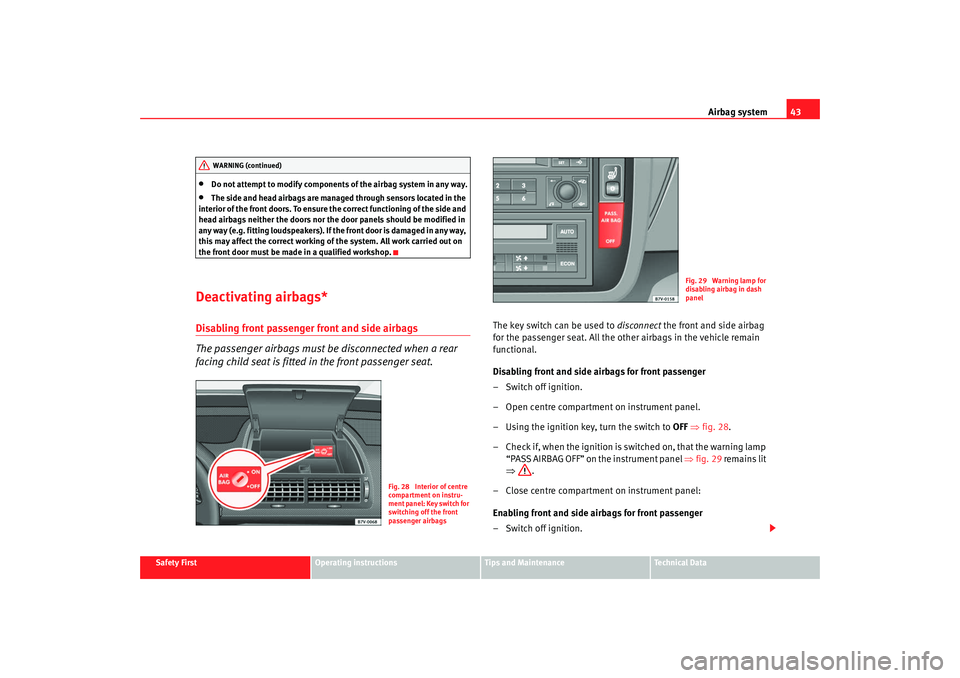
Airbag system43
Safety First
Operating instructions
Tips and Maintenance
Te c h n i c a l D a t a
•
Do not attempt to modify components of the airbag system in any way.
•
The side and head airbags are managed through sensors located in the
interior of the front doors. To ensure the correct functioning of the side and
head airbags neither the doors nor the door panels should be modified in
any way (e.g. fitting loudspeakers). If the front door is damaged in any way,
this may affect the correct working of the system. All work carried out on
the front door must be made in a qualified workshop.
Deactivating airbags*Disabling front passenger front and side airbags
The passenger airbags must be disconnected when a rear
facing child seat is fitted in the front passenger seat.
The key switch can be used to disconnect the front and side airbag
for the passenger seat. All the other airbags in the vehicle remain
functional.
Disabling front and side airbags for front passenger
–Switch off ignition.
– Open centre compartment on instrument panel.
– Using the ignition key, turn the switch to OFF ⇒fig. 28 .
– Check if, when the ignition is switched on, that the warning lamp “PASS AIRBAG OFF” on the instrument panel ⇒fig. 29 remains lit
⇒ .
– Close centre compartment on instrument panel:
Enabling front and side airbags for front passenger
–Switch off ignition.
WARNING (continued)
Fig. 28 Interior of centre
compartment on instru-
ment panel: Key switch for
switching off the front
passenger airbags
Fig. 29 Warning lamp for
disabling airbag in dash
panel
alhambra_ingles_0708 Seite 43 Mittwoch, 10. September 2008 10:55 10
Page 46 of 295
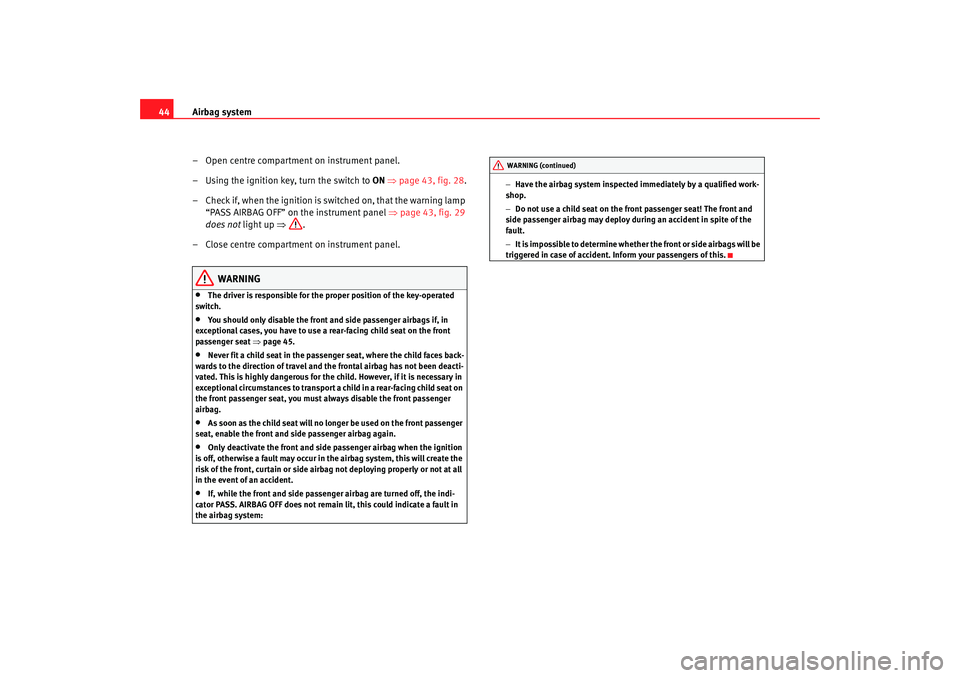
Airbag system
44
– Open centre compartment on instrument panel.
– Using the ignition key, turn the switch to ON ⇒page 43, fig. 28.
– Check if, when the ignition is switched on, that the warning lamp “PASS AIRBAG OFF” on the instrument panel ⇒page 43, fig. 29
does not light up ⇒ .
– Close centre compartment on instrument panel.
WARNING
•
The driver is responsible for the proper position of the key-operated
switch.
•
You should only disable the front and side passenger airbags if, in
exceptional cases, you have to use a rear-facing child seat on the front
passenger seat ⇒page 45.
•
Never fit a child seat in the passenger seat, where the child faces back-
wards to the direction of travel and the frontal airbag has not been deacti-
vated. This is highly dangerous for the child. However, if it is necessary in
exceptional circumstances to transport a child in a rear-facing child seat on
the front passenger seat, you must always disable the front passenger
airbag.
•
As soon as the child seat will no longer be used on the front passenger
seat, enable the front and side passenger airbag again.
•
Only deactivate the front and side passenger airbag when the ignition
is off, otherwise a fault may occur in the airbag system, this will create the
risk of the front, curtain or side airbag not deploying properly or not at all
in the event of an accident.
•
If, while the front and side passenger airbag are turned off, the indi-
cator PASS. AIRBAG OFF does not remain lit, this could indicate a fault in
the airbag system: −
Have the airbag system inspected immediately by a qualified work-
shop.
− Do not use a child seat on the front passenger seat! The front and
side passenger airbag may deploy during an accident in spite of the
fault.
− It is impossible to determine whether the front or side airbags will be
triggered in case of accident. Inform your passengers of this.
WARNING (continued)
alhambra_ingles_0708 Seite 44 Mittwoch, 10. September 2008 10:55 10
Page 48 of 295
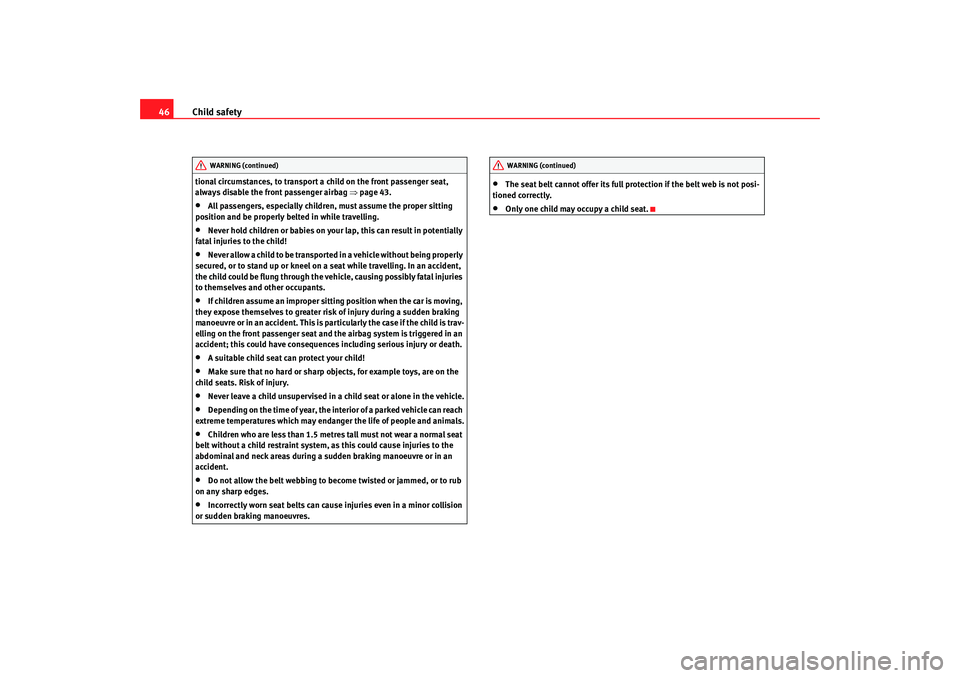
Child safety
46tional circumstances, to transport a child on the front passenger seat,
always disable the front passenger airbag ⇒page 43.•
All passengers, especially children, must assume the proper sitting
position and be properly belted in while travelling.
•
Never hold children or babies on your lap, this can result in potentially
fatal injuries to the child!
•
Never allow a child to be transported in a vehicle without being properly
secured, or to stand up or kneel on a seat while travelling. In an accident,
the child could be flung through the vehicle, causing possibly fatal injuries
to themselves and other occupants.
•
If children assume an improper sitting position when the car is moving,
they expose themselves to greater risk of injury during a sudden braking
manoeuvre or in an accident. This is particularly the case if the child is trav-
elling on the front passenger seat and the airbag system is triggered in an
accident; this could have consequences including serious injury or death.
•
A suitable child seat can protect your child!
•
Make sure that no hard or sharp objects, for example toys, are on the
child seats. Risk of injury.
•
Never leave a child unsupervised in a child seat or alone in the vehicle.
•
Depending on the time of year, the interior of a parked vehicle can reach
extreme temperatures which may endanger the life of people and animals.
•
Children who are less than 1.5 metres tall must not wear a normal seat
belt without a child restraint system, as this could cause injuries to the
abdominal and neck areas during a sudden braking manoeuvre or in an
accident.
•
Do not allow the belt webbing to become twisted or jammed, or to rub
on any sharp edges.
•
Incorrectly worn seat belts can cause injuries even in a minor collision
or sudden braking manoeuvres.
•
The seat belt cannot offer its full protection if the belt web is not posi-
tioned correctly.
•
Only one child may occupy a child seat.
WARNING (continued)
WARNING (continued)
alhambra_ingles_0708 Seite 46 Mittwoch, 10. September 2008 10:55 10